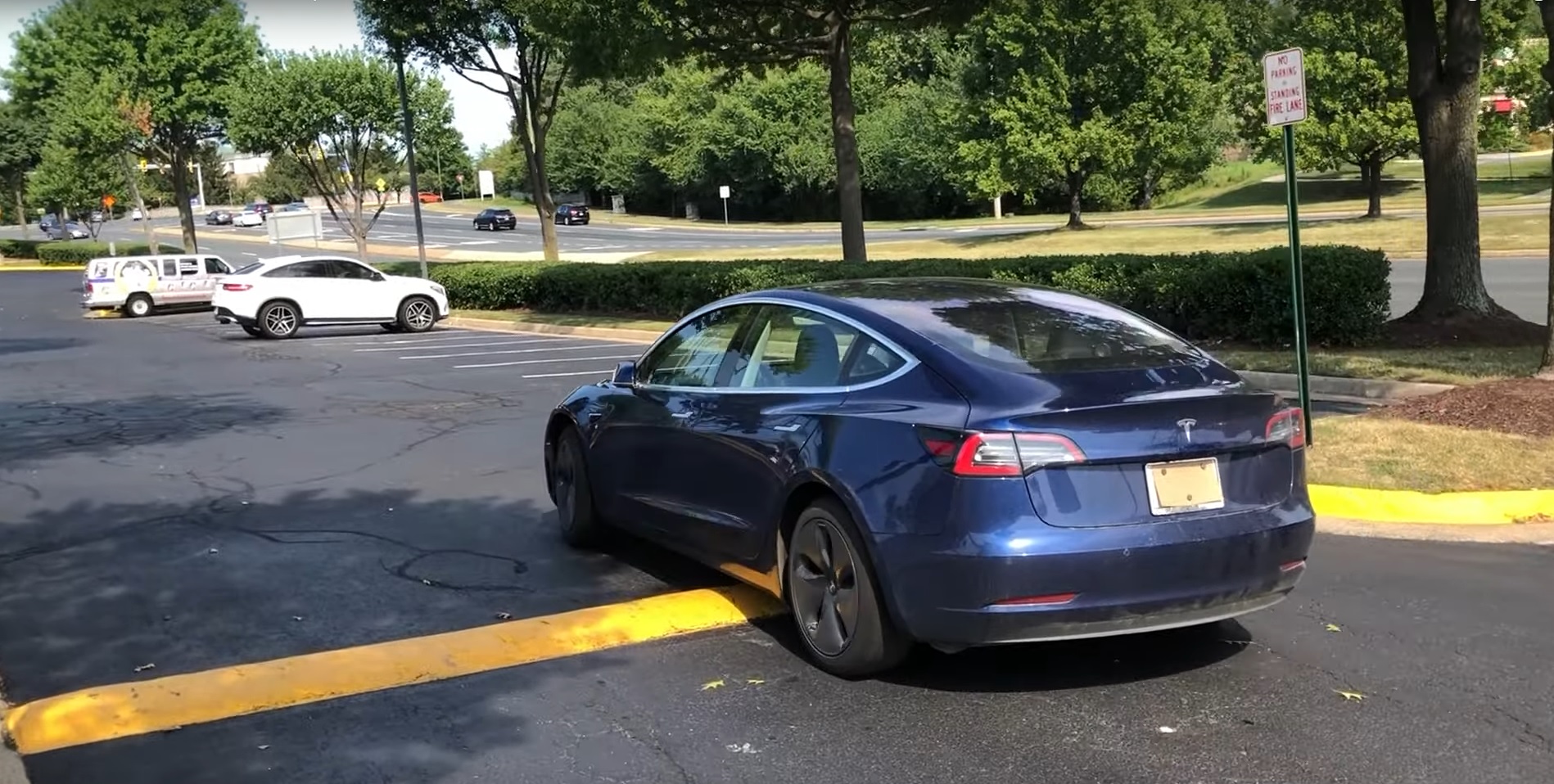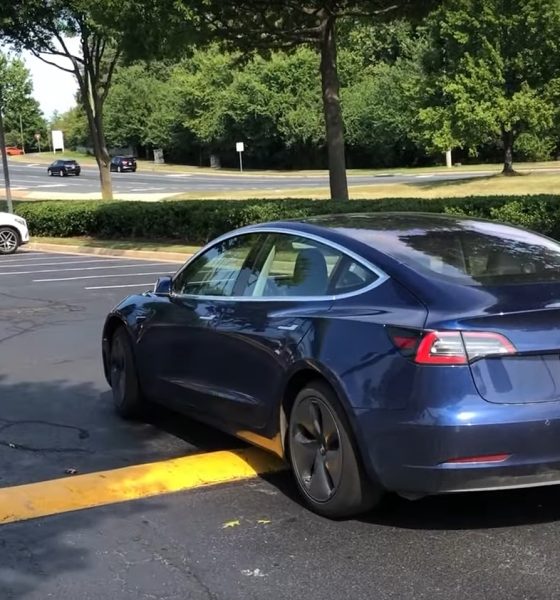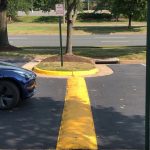

News
Tesla Smart Summon takes on speed bumps and shadows in run up to V10 release
Tesla’s Smart Summon feature is in its fourth iteration, and Early Access Program participants are testing out the most updated capabilities.
A deep blue metallic Model 3 featured in the most recent video published by YouTube channel ALL Electric is seen navigating from various parking spaces to selected point locations, specifically testing its ability to handle speed bumps en route to its programmed Summon location. The Tesla App is also displayed on the screen during the vehicle’s route, showing the real-time planned route of the software as it processes its environment. When unobstructed, Smart Summon handles the speed bumps very well. However, shadows seem to trigger extra visual processing, as seen in the demo, with the Model 3 opting to navigate itself into the lighted part of its path when encountering a partly-shadowed speed bump. Notably, the feature isn’t yet attempting to take account of parking lot markings when determining its route.
Smart Summon, previously ‘Enhanced Summon’, is a set of capabilities that allow drivers to operate their all-electric cars through the Tesla mobile app, specifically by having them autonomously travel to their location. Prior releases have built upon the basic feature in the original Summon that Tesla owners currently have access to, which allows the all-electric vehicles to autonomously drive in a straight line up to 150 feet. Where versions 1-3 of Smart Summon demonstrated slow, hesitant, and jerky movements, the demonstrated fourth version has significantly increased its maneuvering speed and handleds somewhat more complicated parking lot features.
- Smart Summon in a Tesla Model 3 decides to take the lighted part of the speed bump. | (Image: ALL Electric/YouTube)
- Smart Summon in a Tesla Model 3 hesitates at a shadow near a speed bump. | (Image: ALL Electric/YouTube)
In ALL Electric’s prior video showing Tesla’s Smart Summon in its fourth iteration, the same all-electric vehicle seemed confident when reversing from parking spots, and there seemed to be an increase in the Model 3’s speed as it executed the Summon command over the prior versions. One interesting part of that test was the vehicle’s response to the transition from asphalt to brick in its driving path. This caused the feature to pause and assess the locations of the actual curbs vs. the perceived curbs based on color variations. CEO Elon Musk’s previous explanations of the feature’s fine-tuning challenges predicted this. “Yeah, we’ve been working on curbs a *lot*. Concrete seams too. So glamorous,” he tweeted at the end of June.
Smart Summon is expected to improve significantly as more versions are released. Musk previously stated that a Tesla “should be able to drive around a parking lot, find an empty spot, read signs to confirm it’s valid & park.” A wide release of the feature will be included in Tesla’s upcoming Version 10 firmware update, but self-parking looks to still be a ways off yet. Regardless, Smart Summon will undoubtedly provide plenty of advantages to owners, even if limited to personal valet service as an initial offering.
Watch ALL Electric’s Smart Summon V4 latest test below:

News
Tesla aims to combat common Full Self-Driving problem with new patent
Tesla writes in the patent that its autonomous and semi-autonomous vehicles are heavily reliant on camera systems to navigate and interact with their environment.

Tesla is aiming to combat a common Full Self-Driving problem with a new patent.
One issue with Tesla’s vision-based approach is that sunlight glare can become a troublesome element of everyday travel. Full Self-Driving is certainly an amazing technology, but there are still things Tesla is aiming to figure out with its development.
Unfortunately, it is extremely difficult to get around this issue, and even humans need ways to combat it when they’re driving, as we commonly use sunglasses or sun visors to give us better visibility.
Cameras obviously do not have these ways to fight sunglare, but a new patent Tesla recently had published aims to fight this through a “glare shield.”
Tesla writes in the patent that its autonomous and semi-autonomous vehicles are heavily reliant on camera systems to navigate and interact with their environment.

The ability to see surroundings is crucial for accurate performance, and glare is one element of interference that has yet to be confronted.
Tesla described the patent, which will utilize “a textured surface composed of an array of micro-cones, or cone-shaped formations, which serve to scatter incident light in various directions, thereby reducing glare and improving camera vision.”

The patent was first spotted by Not a Tesla App.
The design of the micro-cones is the first element of the puzzle to fight the excess glare. The patent says they are “optimized in size, angle, and orientation to minimize Total Hemispherical Reflectance (THR) and reflection penalty, enhancing the camera’s ability to accurately interpret visual data.”
Additionally, there is an electromechanical system for dynamic orientation adjustment, which will allow the micro-cones to move based on the angle of external light sources.
This is not the only thing Tesla is mulling to resolve issues with sunlight glare, as it has also worked on two other ways to combat the problem. One thing the company has discussed is a direct photon count.
CEO Elon Musk said during the Q2 Earnings Call:
“We use an approach which is direct photon count. When you see a processed image, so the image that goes from the sort of photon counter — the silicon photon counter — that then goes through a digital signal processor or image signal processor, that’s normally what happens. And then the image that you see looks all washed out, because if you point the camera at the sun, the post-processing of the photon counting washes things out.”
Future Hardware iterations, like Hardware 5 and Hardware 6, could also integrate better solutions for the sunglare issue, such as neutral density filters or heated lenses, aiming to solve glare more effectively.
Elon Musk
Delaware Supreme Court reinstates Elon Musk’s 2018 Tesla CEO pay package
The unanimous decision criticized the prior total rescission as “improper and inequitable,” arguing that it left Musk uncompensated for six years of transformative leadership at Tesla.

The Delaware Supreme Court has overturned a lower court ruling, reinstating Elon Musk’s 2018 compensation package originally valued at $56 billion but now worth approximately $139 billion due to Tesla’s soaring stock price.
The unanimous decision criticized the prior total rescission as “improper and inequitable,” arguing that it left Musk uncompensated for six years of transformative leadership at Tesla. Musk quickly celebrated the outcome on X, stating that he felt “vindicated.” He also shared his gratitude to TSLA shareholders.
Delaware Supreme Court makes a decision
In a 49-page ruling Friday, the Delaware Supreme Court reversed Chancellor Kathaleen McCormick’s 2024 decision that voided the 2018 package over alleged board conflicts and inadequate shareholder disclosures. The high court acknowledged varying views on liability but agreed rescission was excessive, stating it “leaves Musk uncompensated for his time and efforts over a period of six years.”
The 2018 plan granted Musk options on about 304 million shares upon hitting aggressive milestones, all of which were achieved ahead of time. Shareholders overwhelmingly approved it initially in 2018 and ratified it once again in 2024 after the Delaware lower court struck it down. The case against Musk’s 2018 pay package was filed by plaintiff Richard Tornetta, who held just nine shares when the compensation plan was approved.
A hard-fought victory
As noted in a Reuters report, Tesla’s win avoids a potential $26 billion earnings hit from replacing the award at current prices. Tesla, now Texas-incorporated, had hedged with interim plans, including a November 2025 shareholder-approved package potentially worth $878 billion tied to Robotaxi and Optimus goals and other extremely aggressive operational milestones.
The saga surrounding Elon Musk’s 2018 pay package ultimately damaged Delaware’s corporate appeal, prompting a number of high-profile firms, such as Dropbox, Roblox, Trade Desk, and Coinbase, to follow Tesla’s exodus out of the state. What added more fuel to the issue was the fact that Tornetta’s legal team, following the lower court’s 2024 decision, demanded a fee request of more than $5.1 billion worth of TSLA stock, which was equal to an hourly rate of over $200,000.
Delaware Supreme Court Elon Musk 2018 Pay Package by Simon Alvarez
News
Tesla Cybercab tests are going on overdrive with production-ready units
Tesla is ramping its real-world tests of the Cybercab, with multiple sightings of the vehicle being reported across social media this week.

Tesla is ramping its real-world tests of the Cybercab, with multiple sightings of the autonomous two-seater being reported across social media this week. Based on videos of the vehicle that have been shared online, it appears that Cybercab tests are underway across multiple states.
Recent Cybercab sightings
Reports of Cybercab tests have ramped this week, with a vehicle that looked like a production-ready prototype being spotted at Apple’s Visitor Center in California. The vehicle in this sighting was interesting as it was equipped with a steering wheel. The vehicle also featured some changes to the design of its brake lights.
The Cybercab was also filmed testing at the Fremont factory’s test track, which also seemed to involve a vehicle that looked production-ready. This also seemed to be the case for a Cybercab that was spotted in Austin, Texas, which happened to be undergoing real-world tests. Overall, these sightings suggest that Cybercab testing is fully underway, and the vehicle is really moving towards production.
Production design all but finalized?
Recently, a near-production-ready Cybercab was showcased at Tesla’s Santana Row showroom in San Jose. The vehicle was equipped with frameless windows, dual windshield wipers, powered butterfly door struts, an extended front splitter, an updated lightbar, new wheel covers, and a license plate bracket. Interior updates include redesigned dash/door panels, refined seats with center cupholders, updated carpet, and what appeared to be improved legroom.
There seems to be a pretty good chance that the Cybercab’s design has been all but finalized, at least considering Elon Musk’s comments at the 2025 Annual Shareholder Meeting. During the event, Musk confirmed that the vehicle will enter production around April 2026, and its production targets will be quite ambitious.










